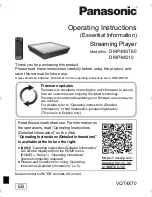
Operating The Media Converter
The MultiPower Industrial Media Converter is a 10/100 auto-negotiating,
miniature media converter. The fiber port always operates at 100 Mbps
FDX; the copper port auto-senses the connected device’s speed and duplex
mode: 10 Mbps or 100 Mbps and HDX or FDX (including Flow Control).
The MultiPower Industrial Media Converter offers plug-and-play operation,
including the AutoCross feature which automatically selects between a
crossover work-station or pass-through connection depending on the connect-
ed device. The MultiPower Industrial Media Converter also protects against
Broadcast storms, and allows jumbo packets of up to 1916 bytes.
LED Operation
Each
MultiPower Industrial Media Converter
includes two LEDs, located
on the RJ-45 connector. LED functions are as follows:
FX LNK/ACT:
Glows green when a link is established on the fiber
port; blinks green when activity is detected on the fiber port.
TX LNK/ACT:
Glows amber when a link is established on the copper
port; blinks amber when activity is detected on the copper port.
DC Terminal Block Wiring Instructions
You can also power the MultiPower Industrial Media Converter with the DC
terminal block. From a power source, connect to any one positive and any
one negative terminal on the converter The following charts illustrate an exam-
ple of the wiring configurations for the 48 VDC DC terminal block of the
MultiPower Industrial Media Converter (±5 to ±50VDC). See the following
page for a diagram showing how to cascade DC power.
NOTE: If you are using stranded wire, you must “tin” the leads; use solid
wire as is.
NOTE: The chassis is protected against mis-wiring; if mis-wired the chassis
will merely not function.
3
3) Hold boards by the edges only; do not touch the electronic components or
gold connectors.
4) After removal, always place the boards on a grounded, static free surface, ESD
pad or in a proper ESD bag. Do not slide the board over any surface.
D C P
O W E R
S
U P P L Y
P
R E C A U T I O N S
The following precautions should be observed when installing chassis with DC
power supplies.
1) Check nameplate ratings to assure there is no overloading of supply circuits
that could have an effect on overcurrent protection and supply wiring.
2) When installing 48V DC rated equipment, it must be installed only per the fol-
lowing conditions:
A) Connect the equipment to a 48V DC supply source that is electrically iso-
lated form the alternating current source. The 48V DC source is to be con-
nected to a 48V DC SELV source.
B) Input wiring to terminal block must be routed and secured in such a man-
ner that it is protected from damage and stress. Do not route wiring past sharp
edges or moving parts.
C) A readily accessible disconnect device, with a 3mm minimum contact gap,
shall be incorporated in the fixed wiring.
3) Grounding: reliable earthing of this equipment must be maintained. Particular
attention should be given to supply connections when connecting to power strips,
rather than direct connections to the branch circuit.
F
E D E R A L
C
O M M U N I C A T I O N S
C
O M M I S S I O N
R
A D I O
F
R E Q U E N C Y
I
N T E R F E R E N C E
S
T A T E M E N T
This equipment has been tested and found to comply with the limits for a Class B comput-
ing device, pursuant to Part 15 of the FCC Rules. These limits are designed to provide rea-
sonable protection against harmful interference when the equipment is operated in a com-
mercial environment. This equipment generates, uses and can radiate radio frequency ener-
gy and, if not installed and used in accordance with the instruction manual, may cause harm-
ful interference to radio communications. Operation of this equipment in a residential area is
likely to cause harmful interference in which the user will be required to correct the interfer-
ence at his own expense.
This digital apparatus does not exceed the Class B limits for radio noise emission from dig-
ital apparatus set out in the Radio Interference Regulation of the Canadian Department of
Communications.
Le présent appareil numérique n'émet pas de bruits radioélectriques dépassant les limites
applicables aux appareils numériques de classe B prescrites dans le Règlement sur le brouil-
lage radioélectrique publié par le ministère des Communications du Canada
.
6


























